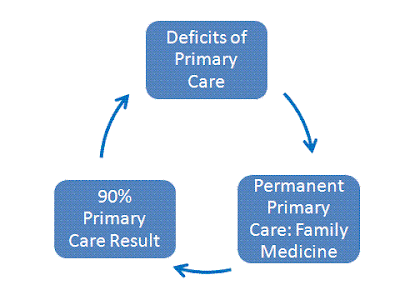The United States has a health policy construct that actually prevents recovery of primary care. Primary care revenue support is insufficient to keep up with the increasing cost of delivering primary care. New types of costs burden primary care practices further. Meanwhile the rewards for non-primary care choices have increased. The rewards are greater for primary care graduates that depart primary care. The rewards are greater for employers who receive more revenue when graduates convert from primary care.
Prevention of Primary Care Recovery By Design

Accelerating cycles of primary care deficits are the result of US policy.
- The cycle starts with primary care deficits.
- Innovative academicians create new sources of primary care. The designs are generic to workforce needs and are not specific to primary care or most needed primary care.
- Despite more sources and increased graduates in each source, there is less primary care result per primary care graduate. Studies contribute to the confusion as they only measure first career choices which fail to capture steady departures from primary care in the years after graduation. Only about 30% of US primary care training results in primary care delivery.
- Innovators propose to fix primary care with more types of primary care and further expansions of annual graduates. Others say that primary care can be fixed with reorganzation (continuity home) or innovative payment designs. No such proposal can work without changes in the US policy construct that increase primary care retention in professionals and other personnel - this requires more primary care spending, especially in 30,000 zip codes with lowest spending by design.
- US policy does not change and this results in less retention of primary care graduates within primary care careers with flexible primary care graduates departing primary care during training, at graduation, and each year after graduation.
- The result is ever more non-primary care with continued deficits of primary care.
The 1980 primary care class year including six primary care sources with 14,000 graduates at 18 Standard Primary Care Years per graduate for 250,000 Standard Primary Care Years for the 1980 class year. The 2012 graduates of six sources will be 28,000 in number but the yield will be only 7 SPCYrs per graduate for a result of 195,000 SPCYrs. Standard Primary Care Year 2012
Since 1980 the United States has had substantial growth of population and primary care demand but the response has not been Specific, Measurable, Achievable, Realistic, or Timely with regard to primary care or the health access needs of most Americans. Tragically the needs are greatest in locations where the elderly, poor, near poor, rural, and underserved populations are found - in 30,000 zip codes that have lower than average to lowest primary care concentrations.
Permanent primary care family medicine is a real solution for primary care and for 200 million Americans in 30,000 zip codes, but permanent primary care choice is actually prevented by policy. Only medical students can choose permanent primary care as nurse practitioner and physician assistant primary care is flexible by design. Only medical students can choose family medicine residency training. Nurse practitioner and physician assistant family practice employed components make the same substantial contributions where needed, but only when remaining in family practice. NP and PA graduates found in family practice employment have decreased to 25% of total graduates. Even when entering family practice with its substantial primary care, rural, and underserved outcomes; the retention is not permanent. Family medicine retains primary care and rural and underserved components because of permanent family practice result.

If the United States only had permanent primary care as the source of primary care, it would know exactly how many graduates were needed each year to supply sufficient primary care. Meeting Primary Care Needs in the Latter Half of the 21st Century
Even with a permanent source, insufficient primary care support will result in a permanent source converted to flexible. Workforce cannot remain where it is not supported. Family medicine has had greater primary care retention in the past. It is possible that this final permanent primary care source could be defeated to flexible and non-primary care. This is quite easy to accomplish as all that is required is for the current design to continue to keep revenue paid below the rapidly increasing cost of delivering primary care.
United States Policy Prevents Permanent Choice as Graduates Prefer Flexible Primary Care Training Sources To Keep Their Options Open or Outright Choose Non-Primary Care
It is not possible to recovery primary care with flexible sources. The US primary care training design is 90% flexible and only 10% permanent. Also the flexible training outcomes have steadily decreased in primary care result per graduate. Ever more graduates are required and even with expansions, the primary care deficit is not erased. A permanent primary care source has different outcomes by design.
The current US design facilitates Three Dimensions of Non-Primary Care Growth with Zero Growth in Primary Care
Permanent Solutions for Primary Care Are SMART
Thanks to all 12,000 who have visited Basic Health Access in 2011.
Robert C. Bowman, M.D. Basic Health Access Web Basic Health Access Blog
Dr. Bowman is the North American Co-Editor of Rural and Remote Health and a Professor in Family Medicine at A T Still University School of Osteopathic Medicine. He was the founding chair of the Rural Medical Educators Group of the National Rural Health Association, he was the long term chair of the STFM Group on Rural Health, he is the founding director of Priority Infrastructure at http://www.infrastructureamerica.org/ and he is the author of the World of Rural Medical Education, and Physician Workforce Studies
Related Post:
Widget by [ Iptek-4u ]
